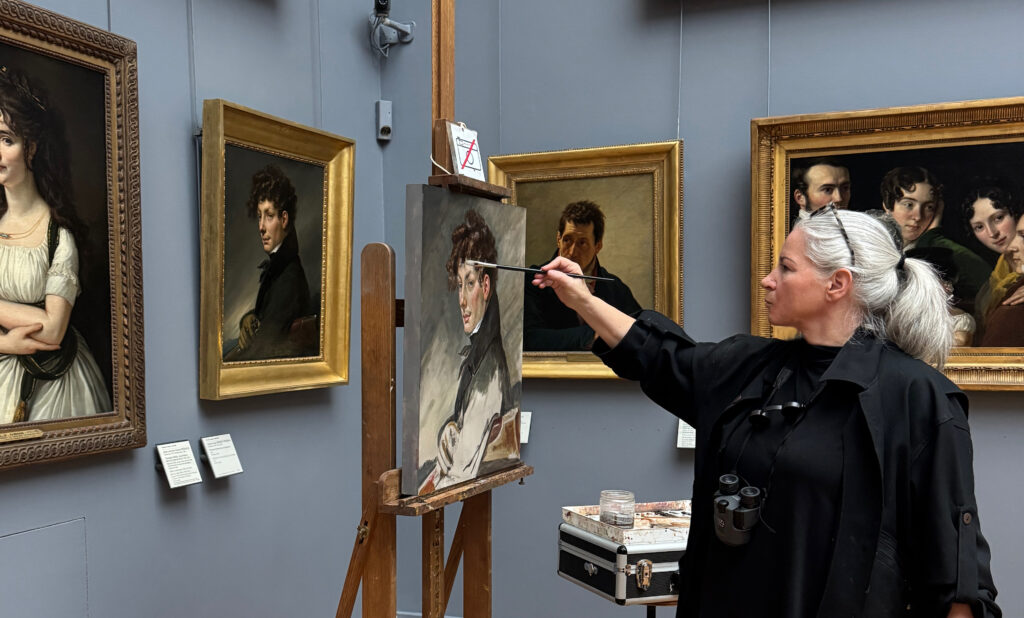“You are part of a chain of artists who have copied in the Louvre. You are part of this history.”
The desire to create is deeply inside each and every one of us — and few stories capture that truth better than this week’s guest, Robin Damore.
A celebrated American portrait artist whose work hangs in permanent collections across the United States, Robin is currently living every artist’s dream: painting inside the Louvre as part of its historic copyist program. 🎨
We first met by chance — on a Paris bus — as Robin was on her way to her first day painting in the Louvre. Since then, her story has unfolded into one of dedication, passion, and reverence for art’s timeless lineage.

Becoming a Louvre Copyist
Robin’s journey began over twenty years ago, when she first visited the Louvre and picked up a paper application to become a copyist. Life carried her elsewhere, but the dream never left her.
Years later, a chance encounter online with another artist reignited her ambition. She applied — in French, through Google Translate — and was rejected. Three times.
Finally, in April, she received her long-awaited approval. Out of thousands of artists worldwide, only about 50 permits are issued each year. When she arrived, her orientation came with a moving message from the program director:
“You are part of a chain of artists who have copied in the Louvre. You are part of this history.”
Robin’s permit allows her to paint in the museum for up to three months, though she’s staying for one. Currently, there are only 22 active copyists inside the Louvre at any given time — each quietly carrying forward a centuries-old tradition.
A Day Inside the Louvre
Each morning, Robin enters through the employee entrance, skipping the lines with her official copyist badge. Her painting supplies are stored in a fire-safe closet, and she’s assigned a numbered easel and stool.
“The easels are on wheels. I can roll mine through the gallery to my painting’s spot,” she explains.
Robin is currently recreating Le Chasseur de la Garde Nationale en Uniforme de Chasse (1811) by Jean Brood, a student of Jacques-Louis David. The painting depicts a young man in hunting attire — radiant, enigmatic, and full of character.
She works on a cradled gesso panel rather than canvas:
“I love the smooth surface. It’s perfect for portrait work. And the cradle creates a hollow space behind the board — I use that to build a little time capsule.”
In that hidden space, Robin places mementos from the painting: the brushes she used, a robin’s-egg token from her studio, even pieces of clothing from her subjects.
“It’s something to be discovered later — a story about the time, the person, and the art.”

Painting in the Midst of History
Robin’s timing in Paris coincided with heightened security following a robbery at the Louvre, adding unexpected tension to her residency. Yet she remains undeterred.
“There’s something sacred about painting from the original,” she says. “I use binoculars to see the subtleties — the greens, the pinks, the tiny shifts of color that disappear in photographs. You can feel the painter’s breath through the brushstrokes.”
Each day is a meditation on patience, reverence, and connection — a dialogue between artists separated by centuries but united by the same creative pulse.
The Artist Behind the Easel
Before becoming a painter, Robin was a photographer. She now combines those skills when creating portraits, traveling across the U.S. with a portable studio.
“When I paint someone, I’m always looking for what’s most beautiful about them. Every person has that — young or old, everyone carries beauty.”
Her portraits include prominent figures such as a federal appeals court judge (whose portrait now hangs near the White House) and the Governor of Oregon. Yet her most celebrated work is the portrait of Nichelle Nichols, the beloved Lt. Uhura from Star Trek, acquired by the Smithsonian’s National Portrait Gallery in 2023.
From Star Trek to the Smithsonian
Robin’s painting of Nichelle Nichols went viral after she shared a video of unveiling it to the actress, who was moved to tears.
“I expected a few hundred likes. It got over a hundred thousand.”
That single video led to the Smithsonian acquiring the painting — an honor she describes as her “Academy Award moment.”
“To have a piece in the Smithsonian, cared for far into the future — it’s beyond words.”
The museum later revealed that it was the curator’s son who saw the viral post and brought it to her attention — proof of how modern visibility can carry timeless art into history.

Lessons in Art and Humanity
“Painting has taught me that we all want to be seen at our best,” Robin reflects. “Everyone has beauty, and my job is to find it.”
Her work — whether in a French museum or an American courtroom — is an act of empathy and legacy. Through her portraits, she captures not only likeness but story, spirit, and time itself.
Connect with Robin Damore
🌐 robindamore.com
📸 Instagram @robindamore





